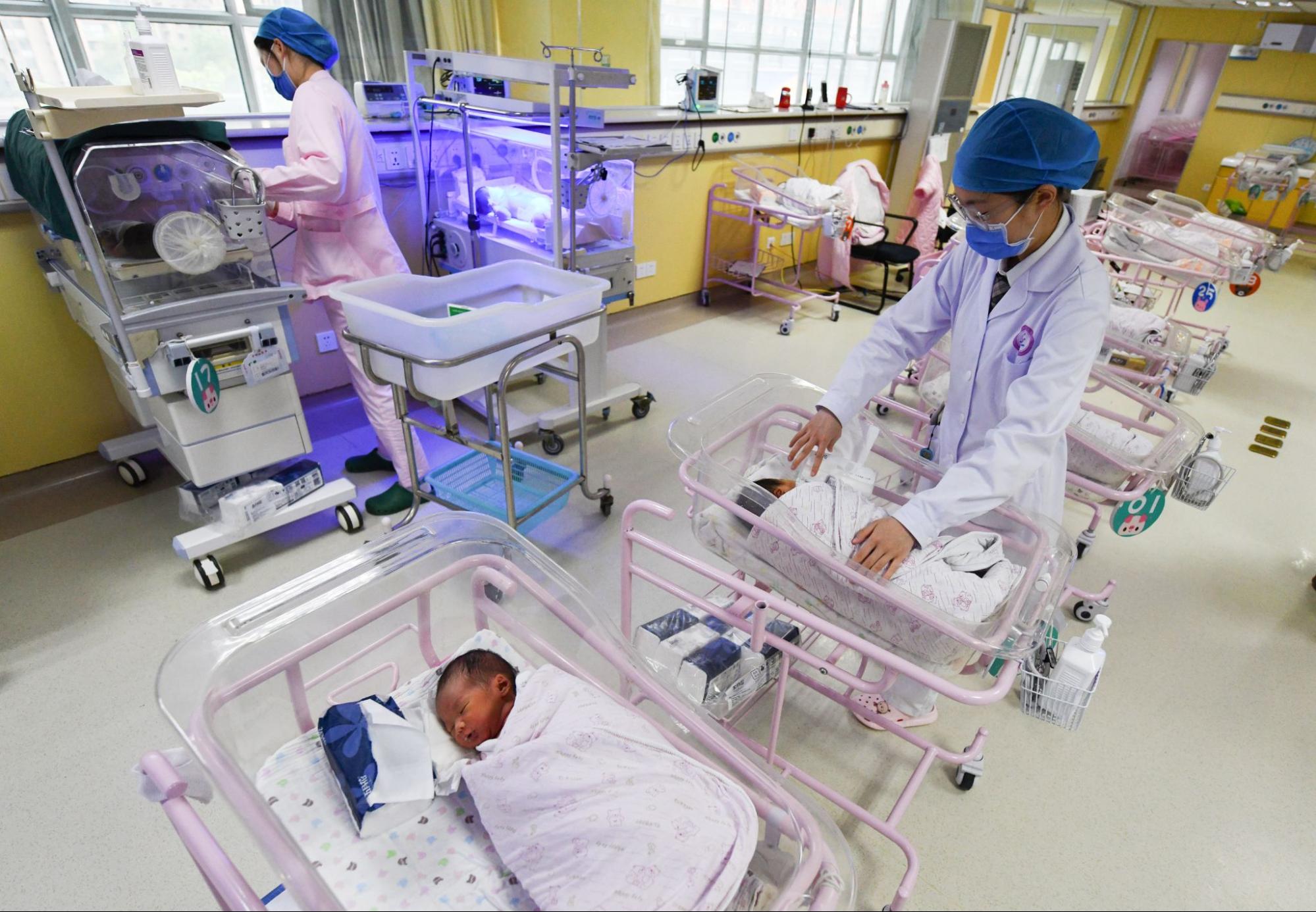Embrace the pain? Epidural use in China remains low.
Despite a governmental initiative launched in 2018 to promote the use of epidurals for vaginal childbirth, more than half of Chinese women still have to endure excruciating pain in the delivery room. Here’s why.

Shěn Yìwén 沈奕雯 was lambasted for being “too posh to push” when she raised the idea of having an epidural-induced childbirth at a family gathering in 2021. She was six months pregnant at the time, and after going through a complicated labor for her first child — which involved a cesarean section, a surgical procedure that involves cutting into a mother’s abdomen to deliver a child — Shen wanted her next one to be as smooth and pain-free as possible.
“I was traumatized. I remember repeatedly saying I wanted to die,” the 34-year-old accountant from the southeastern city of Suzhou told The China Project.
But Shen’s proposal was sternly criticized by her mother-in-law, who said that because she managed to have three children through non-medicated natural births, Shen “should be able to do that as well.”
“I’d done enough research at that point and I was determined,” Shen continued. “But my mother-in-law kept warning me about the so-called side effects of epidurals on babies, though she couldn’t provide any evidence when I challenged her.”
Shen ended up leaving the argument with her mind unchanged. About four months later, she delivered a newborn with the help of epidural anesthesia. “He couldn’t be healthier, stronger, or more perfect,” Shen said. “Looking back, that was perhaps one of the most amazing decisions I’ve ever made.”
Shen is among a growing number of Chinese women requesting pain-relieving treatment during childbirth in a country where the traditional belief is that intense labor pain is inevitable. For a long time, having a surgical procedure was the preferred way for laboring women to evade the problem, and many doctors suggested it for convenience and for fear of facing malpractice allegations raised by patients. Six years ago, 35% of all Chinese babies were delivered by C-section.
China news, weekly.
Sign up for The China Project’s weekly newsletter, our free roundup of the most important China stories.
But the pendulum has been swinging. Under the influence of a government campaign launched in 2018, more and more Chinese women have come to know about epidurals and included them in their birth plans. “After my first delivery, I told myself I would never do this again. I literally went through hell to bring that baby to this world,” Shen said. “But my mind changed after I learned about epidurals. When I was assured by my hospital that anesthetic services were available, that cleared my fear and anxiety of childbirth.”
Epidurals — described as “the greatest invention of all time” by Shen — are not available for everyone, though. Despite the surging awareness of pain management methods, a majority of pregnant women are still denied the treatment.
Too many C-sections
Although C-sections are necessary and lifesaving in certain situations, they are still major surgeries and can lead to significant complications, which is why the World Health Organization recommends the procedure only be undertaken when medically necessary. Once C-section rates climb higher than 10% in a country, there is no evidence that they help reduce maternal and newborn mortality.
China has long been criticized by global health authorities for its high rate of C-sections. In 2010, nearly half of the 16 million babies born that year were from cesarean delivery, an increase from 10% in the 1980s and the highest documented rate in the world. Although the number fell to 34.9% in 2014 due to a variety of initiatives taken by the government, it still meant that one in three babies in China at the time were delivered by cutting the mother’s abdomen and uterus. Since 2018, the cesarean delivery rate has been surpassing 40% in urban areas and has approached 35% in the countryside, far exceeding the 10% to 15% recommended by WHO.
The reasons vary, from a lack of information among many pregnant women to a preference among doctors to carry out the procedure, as it takes less time and costs more than vaginal births.
When Charlotte Hu, the mother of a 21-year-old daughter born via cesarean section, was pregnant, her parents initially tried to convince her to have a natural birth because “their generation grew up thinking every woman could do that,” she told The China Project. Hu, however, feared pain and wanted “something quick and predictable,” she said.
Hu admitted that her decision was also influenced by opinions from people around her, who believed that surgical childbirth was safer for both mother and child. Although scientific evidence proves that to be myth and suggests the procedure should be performed only in case of emergency, Hu went for the surgery in order to avoid any potential misstep during the birth. “The one-child policy was still in place when I was pregnant, so I desperately wanted to get it right,” she added.
For women of childbearing age in China today, although the pressure to have a successful first delivery is less intense than before with the relaxation of birth limits, fear of labor pain remains. According to an online survey released in 2020 that asked 4,030 Chinese childbearing-aged young adults about their future family plans, among those who said they were uncertain about having children, about 35% of them cited “pain in childbirth” as their top reason.
For Shen, whose first delivery lasted an excruciating 37 hours, “what was more frightening than the pain was the feeling of losing control in the labor ward,” she said. “I did everything I could to prepare for a natural birth. I did prenatal yoga, took supplements religiously, learned Lamaze breathing, watched videos of women going through labor. You name it. But when things didn’t go well, I felt like the whole world just crumbled and I no longer had a say in my own childbirth.”
Luckily, Shen was conscious enough to give consent to a C-section, which brought her first child to the world safe and sound. But in Chinese labor rooms, things can get chaotic. In one case that dominated local headlines in 2017, a 26-year-old expectant mother in labor jumped to her death from the fifth floor of a hospital in Yulin, in northwestern China’s Shaanxi Province, after her family repeatedly refused to let her have a C-section. In a different type of case one year later, a man was detained after assaulting doctors at a Beijing hospital, who originally refused to perform a C-section on his wife for medical reasons.
Epidurals: Growing awareness, but still underused
In an effort to lower cesarean delivery rates, Chinese health officials had tried a number of measures over the years. In 2001, the National Health and Family Planning Commission first highlighted reducing C-section rates as a national priority in its 10-year plan. The vow was renewed 10 years later, after a WHO paper showed the rate stood at 46%. In some provinces, hospitals were fined or risked being shut down if they failed to meet the ideal rate set by the local government.
Amid all of these initiatives, there was a renewed sense of urgency in 2015 when China scrapped its one-child policy, allowing most couples to have two children for the first time since the draconian population control rules were introduced more than four decades ago. In anticipation of a baby boom, the National Health Commission (NHC) announced a pilot program in 2018 to encourage natural births, where over 900 hospitals across the country were selected to increase the use of and improve the quality of spinal or epidural anesthesia procedures — which involve an injection of anesthetic into or around the spinal cord to numb some of the pain of childbirth, as well as to strengthen the training of anesthesiologists, obstetricians, and midwives.
By the end of 2020, the directive said, 40% of Chinese women choosing natural childbirth should receive an epidural, in comparison with 10% in 2018.
Since then, the trend has been moving toward vaginal childbirth. Shen recalled that at the initial consultation for her second pregnancy at a local maternal hospital, she was “fully expecting to have a C-section scheduled.” However, “the doctor basically told me that the procedure is off the table unless there’s a compelling reason to justify it,” she said. Instead, Shen was introduced to the idea of natural childbirth facilitated by anesthesia, an option that was unavailable during her first pregnancy.
The progress toward epidural-induced childbirth is documented in a report unveiled at a press conference last October, where Mǐ Wèidōng 米卫东, an anesthesiologist at NHC leading the task force in promoting epidurals, noted that at the pilot hospitals, anesthesia was used in 53% of natural delivery in 2020 — an annual increase of 10% since 2018.
But Mi also stressed that although 82% of the women surveyed in the national study said they would opt for pain intervention in childbirth, only 30% of expectant mothers actually had access to anesthetic services. “We are still far behind developed countries, where the figure has already reached between 80% and 90%,” Mi remarked.
Mi’s presentation also shed light on how misconceptions about epidurals impeded governmental efforts, as more than one-fifth of the respondents feared that anesthesia could harm newborns and mothers.
There is also a much more practical reason why epidural-induced childbirth is not widespread in China yet. The country’s healthcare sector has a severe workforce shortage, especially of anesthesiologists and nurses skilled in administering other pain-relieving treatment, particularly in rural areas. In an interview with Dingxiangyuan, an influential health information provider widely trusted by China’s medical community, an anonymous anesthesiologist working at a comprehensive hospital in a major city revealed that in many instances where laboring women requested epidurals but got denied, anesthesiologists in her department were either occupied with assignments elsewhere or outside working hours.
“Unlike other surgeries that can be scheduled, childbirth is unpredictable. On good days, we would be informed by the department of obstetrics of how many pregnant women might need epidurals for childbirth. But what happens more often is that we would be called in abruptly,” the person said. “It’s not worthwhile for us to be on call 24 hours if only one epidural-assisted childbirth happens on that day, given that one injection only adds 200 to 300 yuan ($28 to $42) to our paycheck.”
Chinese women are wielding greater autonomy in the maternity ward
In China, the recent emergence of natural childbirth coincided with a collective realization among Chinese women — especially those who are young and financially independent — that they are entitled to assert control over every aspect of their lives, including in the delivery room.
As soon as she found out she was pregnant with her first child, Yōuyōu 幽幽, a 27-year-old mother in Shanghai who requested a pseudonym to protect her privacy, signed herself and her husband up for a childbirth education class to gather information and lessen their anxiety about the birthing process. Hoping to keep exercising while pregnant, which she learned from the teacher could help induce labor naturally, Youyou, a music teacher at a local elementary school, hired a special personal trainer to create a workout plan customized to her physical needs and different stages of her pregnancy.
“I was extremely motivated and wanted to be an active participant in my pregnancy and childbirth,” she told The China Project. Youyou was part of a WeChat group where its 300-plus members were like-minded pregnant women who consumed and exchanged information about childbirth. “I learned so much from my conversations with other members of the group, probably more than from my own doctors. We updated each other daily about our body changes and new advice we came across.”
After gathering enough information, Youyou concluded that an epidural-induced vaginal birth would be the best for her and her baby. In February, her first child arrived at 3.5 kilograms (7.7 pounds).
Youyou’s positive experience with the community made her think that her generation is undergoing a major cultural shift, where “women want to take the issue into their own hands and demand more control over how they give birth,” she said.
However, she admitted that she was in a uniquely privileged position where she could access all the resources she needed. “I’d imagine it’s hard for someone in a less prosperous area to actually get to choose what they want.”

